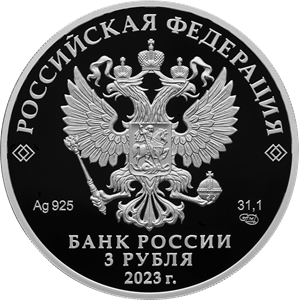Viktor Tsoi’s Creative Work
Obverse
a relief image of the National Coat of Arms of the Russian Federation and a semicircular inscription above it along the rim ‘РОССИЙСКАЯ ФЕДЕРАЦИЯ’ (RUSSIAN FEDERATION) framed with paired diamonds on both sides, under the coat of arms are the chemical symbol of the metal and fineness on the left and fine metal content and the mint trade mark on the right, at the bottom in the centre, in three lines, are an inscription ‘БАНК РОССИИ’ (BANK OF RUSSIA), the coin denomination ‘3 РУБЛЯ’ (3 RUBLES), and the year of issue ‘2023 г.’ (2023).
Reverse
a relief image of a portrait of Viktor Tsoi holding a microphone against the background of an image of a guitar with symbolic flames, laser treated for matte finishing, the relief inscription ‘ВИКТОР ЦОЙ’ (VIKTOR TSOI) on the left around the circumference, and the years of his birth and death ‘1962’ and ‘1990’ in two lines below.
Authors
Designers: E.V. Kramskaya (obverse), S.V. Sutyagin (reverse).
Sculptors: A.A. Dolgopolova (obverse), A.N. Bessonov (reverse).
Mint: Saint Petersburg Mint (СПМД).
Edge: 300 corrugations.
Discover more
Viktor Tsoi (1962–1990) was a Soviet musician, songwriter, actor and artist who became a living legend in the 1980s.
Tsoi displayed his talents yet in a nursery school. He was very good at drawing, and he also could easily repeat any melody, even the most sophisticated one, tapping out a tune with his hand. In the 1970s, Tsoi was for the first time involved in a rock music project as a member of the band Palata No. 6 (Ward No. 6) where he played a bass guitar. In the summer of 1981, Tsoi gave his first onstage performance in the Leningrad cafe Tryum. It is assumed that after these concerts, Tsoi with two other musicians formed the band Garin i Giperboloidy (Garin and the Hyperboloids) which soon was renamed Kino.
The band released its debut LP in 1982. The album was called 45 because its playing time was 45 minutes. In 1984, Kino performed at the Leningrad Rock Festival, where Tsoi’s song ‘I declare my house a nuclear free zone’ was recognised as the best one, and the band became a laureate of the Festival. The songs from the Festival programme were later released as a separate album titled Nachalnik Kamchatki (Chief of Kamchatka). The band made another triumphant appearance at the 1985 rock festival. The success encouraged Tsoi and his bandmates to start recording the next album. Soon the album Eto Ne Lyubov (This Is Not Love) was released, which became a major success in the Soviet Union. The name of Viktor Tsoi became known to the Soviet youth.
Tsoi was not only a songwriter and singer, but he was also an actor. He made his first appearance in the diploma work of film director Alexey Uchitel – the documentary film Rock. Later, Tsoi was invited as an actor more and more often. He starred in the films Yaya-Khkha by Rashid Nugmanov and Assa by Sergey Solovyov. Tsoi played a leading role in the film Igla (The Needle) directed by Rashid Nugmanov. During a year, more than 14 million Soviet people watched this film, and the Sovetsky Ekran (Soviet Screen) magazine recognised Viktor Tsoi as the best actor of 1989.
Along with his music and work in cinema, Tsoi remained a gifted artist. He was a member of the Novye Khudozhniki (New Artists) art group that continued the heritage of the avant-garde of the 1920s and foreign artists, such as pop art, comics, and American graffiti. All this deeply influenced Viktor Tsoi’s works. They were colourful, expressive, with deliberately simplified forms. He did not have his own art studio, so he did his paintings wherever and on everything he had at hand, commonly, on pieces of paper, cardboard, and even polyethylene.
However, for the Soviet youth, Viktor Tsoi was first and foremost a rock legend. After the release of the album Gruppa Krovi (Blood Type), Tsoi’s songs were played at every street corner, and at every home concert. Many young people were impersonating the Kino frontman, copying his behaviour, and even began to dress à la Tsoi.
In the spring of 1989, Kino released the album Zvezda Po Imeni Solntse (A Star Called the Sun) that was recorded by the band in a professional studio.
On 15 August 1990, the Moskvich car, driven by Viktor Tsoi, collided with a bus at high speed. The remaining musicians released the band’s last LP Chyorrny Albom (The Black Album) after the death of its leader. Fans of Kino celebrate Viktor Tsoi’s memorial day on 15 August.
Source: https://www.culture.ru


